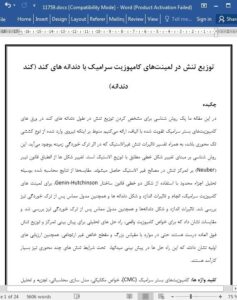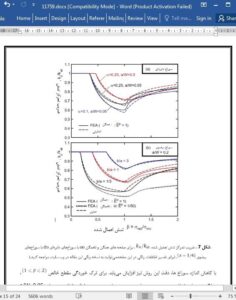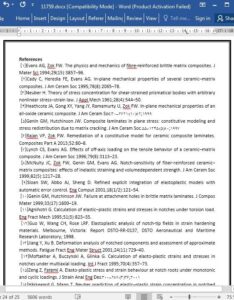Abstract
We present a methodology for determining stress distributions ahead of blunt notches in plates of fiber-reinforced ceramic–matrix composites subject to uniaxial tensile loading, accounting for the effects of inelastic straining due to matrix cracking. The methodology is based on linear transformations of the corresponding elastic distributions. The transformations are derived from adaptations of Neuber’s law for stress concentrations in inelastic materials. Comparisons are made with results computed by finite element analysis using an idealized (bilinear) form of the Genin–Hutchinson constitutive law for ceramic composite laminates. Effects of notch size and shape as well as the post-cracking tangent modulus are examined. The comparisons show that, for realistic composite properties, the analytical solutions are remarkably accurate in their prediction of stress concentrations and stress distributions, even in cases of large-scale and net-section inelasticity. Preliminary assessments also demonstrate the utility of the solution method in predicting the fields under multiaxial stressing conditions.
1. Introduction
Notch sensitivity, characterized by the ratio of the notched to unnotched tensile strength, is a key performance metric of fiber-reinforced ceramic–matrix composites (CMCs). When low, it enables design of components with complex geometric features and with attendant stress concentrations using elastic analyses and low ‘knock-down’ factors. As in metals, stress concentrations in CMCs are mitigated by inelastic deformation, albeit through markedly different mechanisms [1,2].
The principal mechanisms operative in notched CMC laminates and their evolution with applied load are illustrated in Fig. 1. At moderate loads, matrix cracking produces inelastic strain. Its effect is to redistribute stresses at the notch tip and lower the stress concentration. At a critical load, deformation ahead of the notch becomes localized into a macroscopic band comprising a matrix crack bridged by a combination of broken and intact fibers. With additional loading, the band extends and eventually becomes unstable; that is, it grows under decreasing load. Its stability is dictated by the plate dimensions as well as its intrinsic mechanical response, characterized, for example, by a bridging traction law (Fig. 1(c)).











